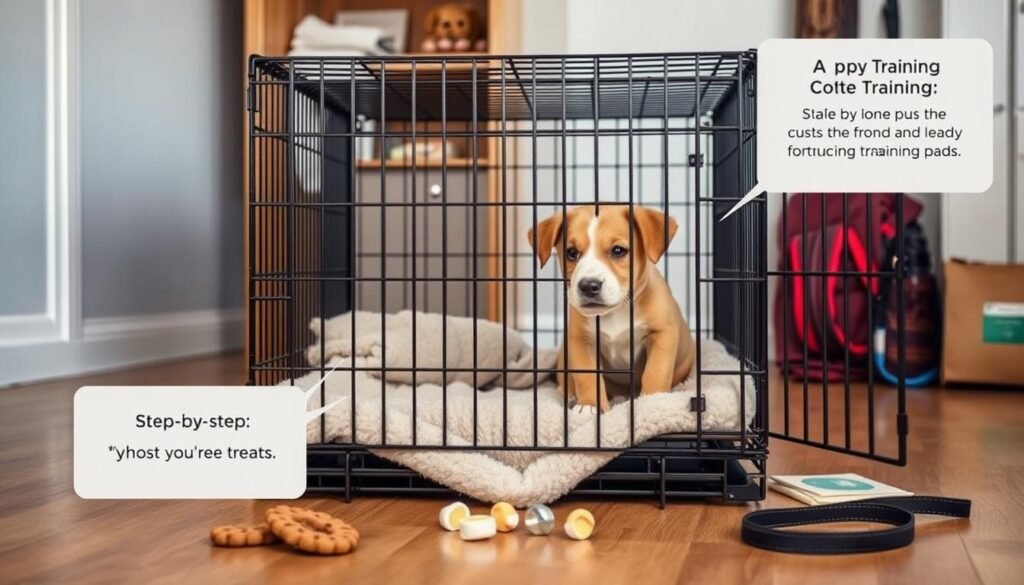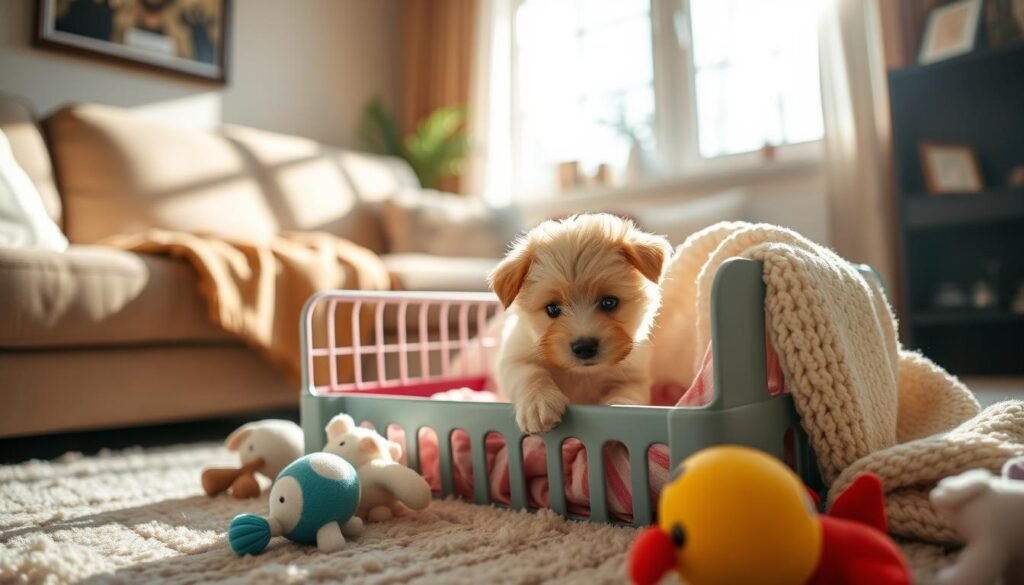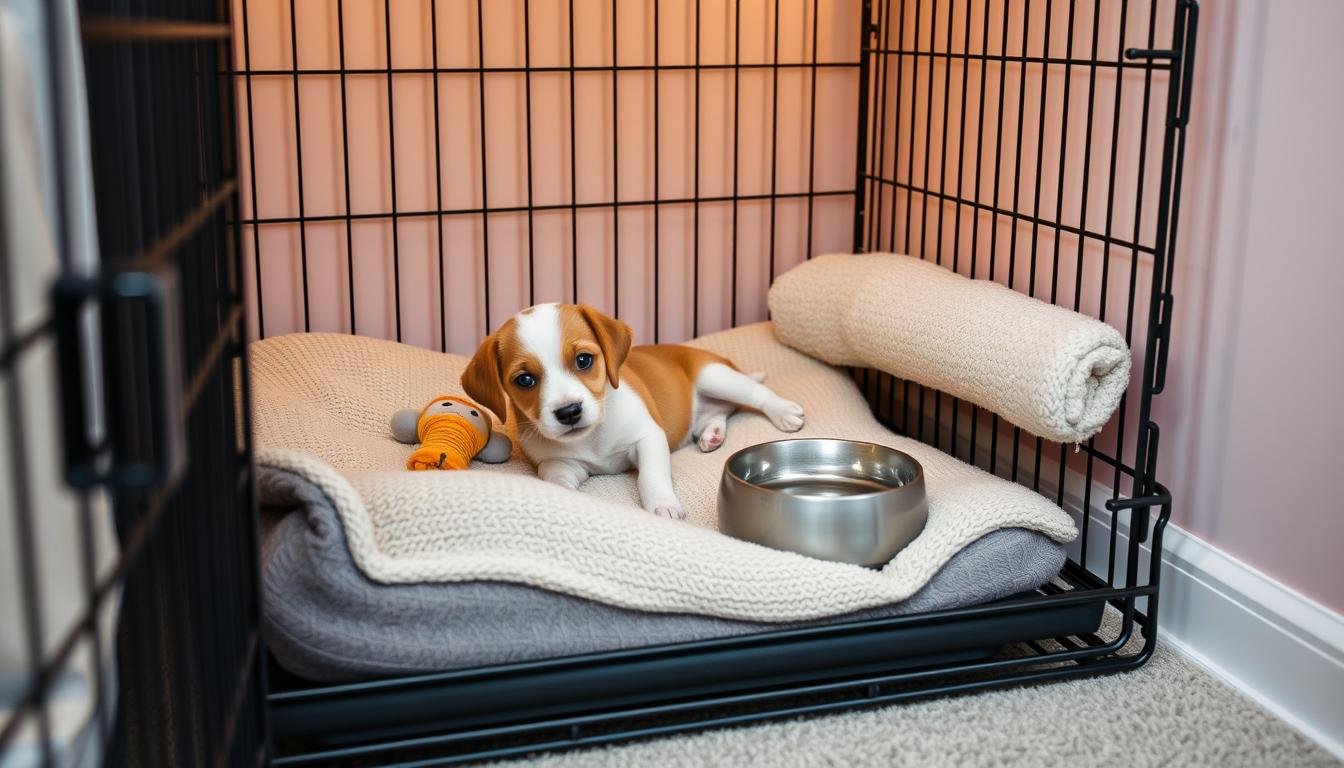Ever thought a simple box could become your puppy’s cozy spot? Crate training is more than just a box. It’s a safe space that feels like home to your puppy. This guide will show you how to make crate training a positive experience.
It’s not about keeping your puppy locked up. It’s about giving them a place to feel safe and secure. Crate training helps with housebreaking, eases separation anxiety, and keeps them safe when you’re away.
Turning a crate into your puppy’s favorite spot takes patience and consistency. Experts agree that these are key to successful crate training. By the end of this guide, your puppy will see the crate as a welcoming place, not a prison.
Let’s work together to give your puppy a cozy, safe space all their own.
Quick Recommendation. Our blog is filled with tips and tricks for training your puppy or dog. If you’re seeking a comprehensive online training program, we recommend K9 Training Institute.
Understanding the Basics of Crate Training
Starting crate training with your puppy taps into their natural instinct for a cozy den. This instinct gives them comfort and security. It’s key to understand this to help your puppy see the crate as a safe place.
The right crate size is essential. It should let your puppy stand, turn, and lie down easily. But it shouldn’t be too big, so they don’t use one end for sleeping and the other for bathroom use. This balance helps in teaching good habits and keeping the crate safe.
Crates are made of metal, plastic, and fabric, each with its own benefits. Metal crates are strong and well-ventilated, perfect for active puppies. Plastic crates are great for travel, offering a snug space. Fabric crates are light and easy to move, ideal for calm dogs who won’t chew on them.
To make the crate safe and inviting, ensure it’s well-ventilated and free from harmful objects. Add soft bedding and safe chew toys to make it cozy. Regular cleaning and upkeep are also important to keep the crate a pleasant place for your puppy.

Preparing for Crate Training: What You Need Before You Start
Starting crate training with your puppy needs some key items. Make sure you have everything before you bring out the crate. A strong, adjustable crate is great for your puppy’s growth.

Where you place the crate is just as important as the crate itself. Put it in a quiet spot where your puppy feels safe and included. Add a soft pillow or a blanket with a comforting smell. Also, include chew toys to keep them busy.
It’s also important to make the crate a cozy space. Choose items that comfort your puppy, like soft bedding and a durable water bowl. This makes the crate a nice place to be and helps with training.
Introducing the crate should be a positive experience. With the right items and approach, your puppy will love their crate. This makes crate training a success.
Introducing Your Puppy to the Crate
Introducing your puppy to the crate should be done slowly and positively. Start by making the crate inviting. Add soft bedding, favorite toys, and treats to catch their eye. A treat can make the crate a welcoming place.
When your puppy first sees the crate, let them explore without feeling trapped. Keep the door open to help them feel at ease. This way, they’ll see the crate as a good place, not a scary one.
Try feeding your puppy near the crate and then inside it. This makes going into the crate a normal part of their day. It helps them see the crate as a positive part of their routine.

Every step should feel natural and comfortable for your puppy. Make these first introductions calm and stress-free. This will help your puppy get used to the crate easily.
Mastering the Lock-In Strategy Without Tears
When teaching your puppy to use a crate, start by adding a little time each day. Begin with just a few minutes and then increase it slowly. Always stay with your puppy at first to help them feel comfortable.

Quick Recommendation. Our blog is filled with tips and tricks for training your puppy or dog. If you’re seeking a comprehensive online training program, we recommend K9 Training Institute.
Use treats and kind words to help your puppy feel good about being in the crate. This positive approach helps them see the crate as a good place. Remember, patience is key. Rushing can make your puppy anxious.
Having a regular crate training schedule is important. It helps your puppy feel secure and in control. Watch how your puppy reacts. If they seem upset, adjust the crate time accordingly.
If your puppy whines or barks, figure out why. Make sure they’re fed, exercised, and have gone to the bathroom before crate time. For nighttime, add a soft blanket or toy to make the crate cozy.
With these tips, crate training can be easy and stress-free for both you and your puppy. It sets the stage for a happy and well-trained pet.
Creating a Positive Crate Training Schedule
Keeping a consistent crate routine is key for your puppy’s comfort. A structured schedule helps your puppy feel secure and stable. It’s like teaching them a dance they can follow every day.
Start by introducing your puppy to the crate slowly. Begin with 10-minute sessions and increase the time as they show they can handle it. It’s important to adapt to your puppy’s pace. Some puppies adjust quickly, while others need more time.
Watch for signs that your puppy is comfortable and ready for longer crate times. A good rule is to mix crate time with play or exercise. This balance meets your puppy’s physical and emotional needs, keeping them healthy and happy.
For example, after 30 minutes in the crate, let your puppy stretch, play, and explore. This makes the crate a safe and positive place for them. It helps in their crate training journey.
Keep an eye on how your puppy reacts to crate time. Look for signs like relaxed entry, less whining, and calmness when in the crate. These signs mean it’s time to increase crate time, but always think about your puppy’s comfort.
Successful crate training is about patience and moving at your puppy’s pace. It’s not about rushing.
The Role of Feeding in Crate Training
Using mealtime inside the crate can really help with crate training your puppy. It makes the crate a good place for them. When they link the crate to food, they start to like being there.
To make this work, put your puppy’s food bowl in the crate with the door open. This lets them go in on their own. It’s important for a calm crate training experience.
Having a crate training feeding schedule is crucial. Being consistent helps your puppy get into a routine. Feed them at the same times every day. Then, you can start closing the crate door while they eat.
If your puppy gets anxious or possessive about food in the crate, you need to make changes. Early action is key. Feeding them in smaller, more frequent portions can help with food anxiety. This makes mealtime in the crate a good experience.
Be patient and consistent with these strategies. Mealtime in the crate should be a positive part of your puppy’s day, not a fight.
Addressing Common Crate Training Challenges
Starting crate training can face obstacles like overcoming crate resistance and dealing with crate anxiety. These issues are common in puppies and older dogs. It’s important to spot these crate training setbacks early to solve them quickly. Here, we’ll share practical steps to tackle these challenges.
First, understand that your dog might feel uneasy about the crate because it’s new. To help, introduce the crate slowly and positively. Put treats or toys inside and use positive words as they explore. This helps change the crate’s image from a confining space to a safe place.
For dealing with crate anxiety, being consistent is crucial. Short, regular sessions help create a routine. This reduces stress and uncertainty for your pet. If your dog shows signs of stress, like whining, stay calm and don’t let them out right away. This can make the anxiety worse.
Instead, wait for a calm moment before opening the crate. Gradually increase the time they spend inside. This helps them feel more comfortable.
Not all crate training setbacks can be fixed at home. If your dog’s anxiety or resistance doesn’t improve, seek help from a professional dog trainer or vet. They can offer specific advice and check for any health issues that might be causing the problem.
With patience and consistency, you can overcome crate training challenges. This will make both your and your dog’s experiences better.
The Do’s and Don’ts of Crate Training
Training your puppy well means knowing the right and wrong ways of crate training. Start by making sure your puppy feels safe and comfortable in their crate. This makes it a cozy space, not a lonely one.
Never use the crate as punishment. This can make your puppy scared of it. Instead, give them treats and praise when they go in or stay calm.
Make the crate a nice place with soft bedding and toys. This helps your puppy feel happy to go in. Also, make sure the crate has good air and is in a quiet, comfy spot in your home.
Remember, crate training is great for housebreaking and teaching good habits. But don’t leave your puppy in the crate for too long. They need to move, go to the bathroom, and play with others to stay happy and healthy.
Conclusion
As we finish this guide, the secret to successful puppy crate training is simple. It’s about being consistent, patient, and positive. Every time you use the crate, make sure it’s a safe and cozy spot for your puppy. Seeing the small steps and big wins in crate training is key.
Building a good relationship with the crate early on is crucial. It helps your puppy’s behavior and happiness. Plus, it gives you peace of mind.
Don’t forget to celebrate the small victories along the way. Whether it’s your puppy sleeping all night in the crate or going in without fuss, every step is a win. The hard work now will lead to a happy and well-adjusted pet.
Remember, every positive moment with the crate strengthens your bond with your puppy. With this guide, you have everything you need for crate training. Keep up the good work and watch your puppy grow into a confident and well-trained dog.
Quick Recommendation. Our blog is filled with tips and tricks for training your puppy or dog. If you’re seeking a comprehensive online training program, we recommend K9 Training Institute.

